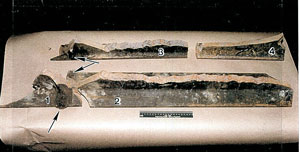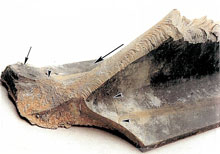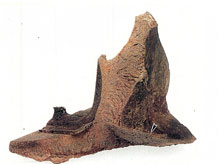Railway Investigation Report R00M0044
Main-track derailment
Canadian National
Freight train Q122-21-09
Mile 163.1, Napadogan Subdivision
Blue Bell, New Brunswick
09 December 2000
The Transportation Safety Board of Canada (TSB) investigated this occurrence for the purpose of advancing transportation safety. It is not the function of the Board to assign fault or determine civil or criminal liability. This report is not created for use in the context of legal, disciplinary or other proceedings. See Ownership and use of content.
-
Table of contents
Summary
On 09 December 2000, at approximately 1512 Atlantic standard time, Canadian National freight train Q122-21-09 derailed seven multi-platform container cars at Blue Bell, near Plaster Rock, New Brunswick, Mile 163.1 of the Napadogan Subdivision. Thirty-six containers were spread over an area covering both sides of the main track for approximately 0.5 km. Eleven of the containers were carrying bags of white asbestos, Division 9.1, UN 2590. Two containers released small amounts of product onto the right-of-way. A total of 660 m of track structure was damaged. There were no injuries.
Ce rapport est également disponible en français.
Factual information
The train was travelling eastward from Montréal, Quebec, destined for Halifax, Nova Scotia. As the train approached Mile 163.1 of the Napadogan Subdivision, a train-initiated emergency brake application occurred. After conducting the necessary emergency procedures, the crew determined that seven multi-platform, double-stack container cars, located 24th to 30th in the consist, had derailed. In all, 24 platforms carrying 36 containers were involved. Several container flats were upside down in the ditches on both sides of the right-of-way. Three containers were subsequently recovered and sent on to their destination.
The train, powered by four locomotives, was approximately 5700 feet in length and weighed about 5200 tons. There were no equipment defects noted on any of the rolling stock, and the train was operated in accordance with company instructions and government safety standards.
Event recorder data indicated that the emergency brake application occurred while the train was travelling at approximately 36 mph, with the throttle in the idle position and the train air brakes released. For 4 minutes and 23 seconds prior to the emergency brake application, the locomotive engineer had been controlling the speed of the train with a moderate application of the dynamic brakes. One second after the dynamic brake was released, the event recorder noted a drop in brake pipe pressure, from 84 pounds per square inch (psi) to 16 psi.
The subdivision was a single main track. The authorized timetable speed between Mile 159.5 and Mile 176.8 was 40 mph, restricted to 35 mph through a curve of 5 degrees, 58 minutes from Mile 163.0 to Mile 163.5. Traffic was controlled by the Centralized Traffic Control System (CTC), authorized by the Canadian Rail Operating Rules (CROR) and supervised by a rail traffic controller (RTC) located in Montréal.
The track structure consisted of 136-pound continuous welded rail, manufactured in 1992 and laid in 1993. The rail was laid on 14-inch, double-shouldered tie plates on hardwood ties, anchored every second tie, and fastened with six spikes per tie. The ballast consisted of two and one-half inches of crushed rock. The curve at Mile 163.0 was a right-hand curve on a descending grade of 0.5 per cent in the direction of train travel.
The track was inspected on the day of the accident by a track supervisor in a Hi-rail vehicle; no irregularities were noted. A track geometry car evaluated the derailment location on 31 October 2000 and no deficiencies were noted. A rail flaw detection car tested the rail for internal defects on 02 December 2000 and no defects were identified.
Several pieces of broken rail from the high rail of the curve were found at, or near, a fractured thermite weld. A review of railway records revealed that a temporary plugFootnote 1 rail was installed in the derailment area to correct a track buckle in the spring of 1999. In October 1999, the plug rail was replaced with a longer piece of rail (21 feet) that was thermite-welded in place. In the summer of 2000, the high rail in the curve was destressedFootnote 2. During the destressing process, two and one-half inches of rail was cut and the rail anchors removed. At the time the rail was re-anchored, the rail temperature was 83 degrees Fahrenheit (F). The preferred rail laying temperature ranges from 80 to 95°F. After the destressing was completed, the entire curve was mechanically resurfaced.
A Hi-rail inspection on 07 December 2000 noted a broken rail (3/4 inch) at Mile 170.7 of the Napadogan Subdivision.
Four pieces from the high rail were removed from the derailment site and sent to the TSB Engineering Laboratory for further examination (report LP 136/00).
The following observations were made:
- The four rail pieces failed as a result of overstress. No pre-cracking was observed on any of the pieces received.
- The overstress failure initiated in the thermite weld, on top of the base of the rail, field side, indicating that the rail was in tension at that location, and consistent with a force applied from the gauge side of the rail.
- Material and hardness results observed on the rail sections were typical of rail material.
- Vertical wear was 9.5 mm, and combined vertical and lateral wear was 19 mm. Both measurements were within allowable wear limits.
- There was light micro-shrinkage porosity in the thermite weld area.
- Microstructure grain size was relatively large within the thermite weld area as compared to the fine grain size in the base metal. The larger grain size of the thermite weld area may facilitate crack propagation once a crack is initiated.
The temperature was approximately -26°C (-14.8°F) at the time of the derailment, with winds ranging from 50 to 70 km/h. In the days before the accident, there had been little snowfall and mainly sunny conditions. The exposed track structure experienced daytime highs reaching 3°C, and overnight lows going down to the minus mid-twenty degrees Celsius range.
White asbestos is described as a slender, fine, flaky fibre. It is considered a low-to-moderate hazardous material that may cause burns to skin and eyes and whose inhalation may damage the lungs. It is used as a heat-resistant material in cement, furnace bricks, and brake linings.
Analysis
The train was operated in accordance with company instructions and government safety standards. There was no evidence of equipment defects that would have contributed to the derailment, such as defective wheel conditions that would have generated high impact loading. The small amount of white asbestos product that was released was recovered without incident.
Information obtained from the accident site shows that, as the train was descending a grade and negotiating a horizontal curve in severe cold weather, the high rail failed at a thermite weld. The first car derailed was the 25th car in the consist. It derailed to the north side of the main track resulting in additional track destruction and the subsequent derailment of six other cars. Examination of the fractured rail revealed that the rail was in tension; the fracture was consistent with a force applied from the gauge side of the rail. The analysis will therefore focus on the stresses generated on the rail and the thermite weld.
There is no information to indicate that the destressing conducted several months prior to the accident was improperly performed. However, surfacing conducted after the destressing operations required portions of the rail to be moved, such as lifting the rail and adjusting the ballast, introducing unknown levels of stress into the rail.
Lateral wear on the high rail was indicative of in-train curving forces exerted upon the rail, creating tensile stresses on the field side of the rail. As the temperature was very low, contraction caused high tensile stressesFootnote 3 in the rail. The combination of tensile stresses generated by in-train curving forces, stresses introduced through surfacing and the low temperature was sufficient to initiate a fracture in the field side of a thermite weld, where large grain size steel microstructure and micro-shrinkage porosity were present.
The limitations of thermite welding are well recognized by the railway industry. The thermite welding process is gradually being replaced with alternative welding techniques (e.g. electric flash butt-welding which provides superior results).
Findings
Findings as to causes and contributing factors
- The derailment occurred due to a rail failure on the high rail of a curve of 5 degrees, 58 minutes.
- The rail failure initiated in a thermite weld and was consistent with a force applied from the gauge side of the rail.
- Surfacing, conducted after the destressing operations, resulted in the introduction of unknown levels of stress into the rail.
- The combination of tensile stresses generated by in-train curving forces, stresses introduced through surfacing and the low temperature was sufficient to initiate an overstress fracture in the field side of a thermite weld, where large grain size steel microstructure and micro-shrinkage porosity were present.
Safety action taken
The question of quality assurance, as well as inspections, of field welds has been under review by both Canadian National's (CN) and Canadian Pacific Railway's engineering management for some time. Gradual replacement of the thermite welding process includes a number of procedural and process improvements that are designed to improve the quality of welds and the methods of inspection by CN. These improvements include, but are not limited to, the following:
- improvements in the quality of the thermite weld kits;
- introduction of clean steel practice by the steel mills;
- increased rail testing frequency, using ultrasonic rail flaw detection cars;
- improvements in the rail testing process and technology, leading to new automated systems which have improved defect pattern recognition capabilities;
- continuous thermite weld quality assurance of the batches (lots) by the supplier; and
- improved training of railway personnel.
This report concludes the Transportation Safety Board's investigation into this occurrence. Consequently, the Board authorized the release of this report on .
Appendices
Appendix A - List of supporting reports
The following TSB Engineering Laboratory report was completed:
- LP 136/00 - Rail Failure, Mile 163.1, CN Napadogan Subdivision





